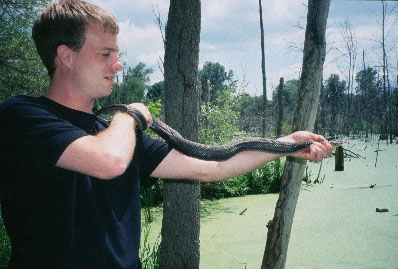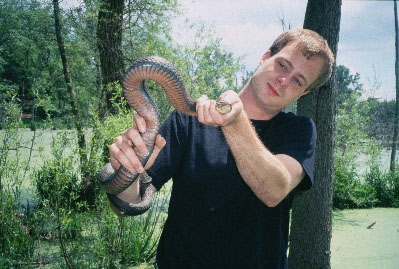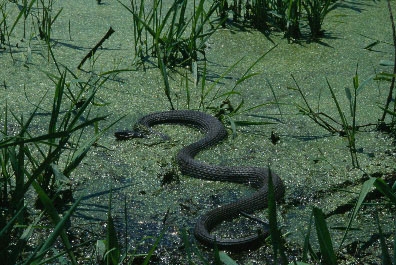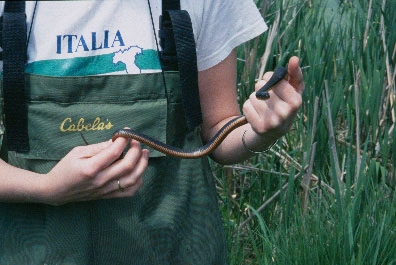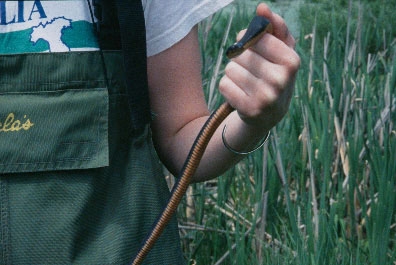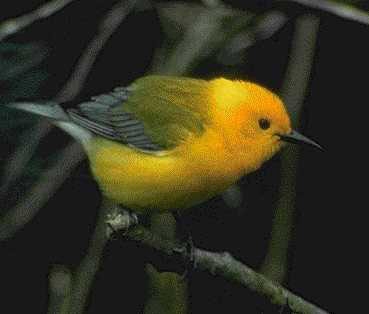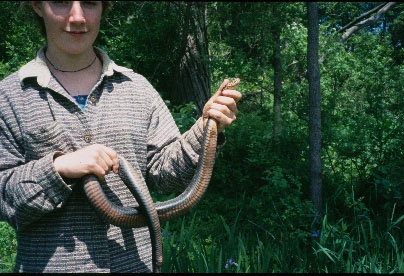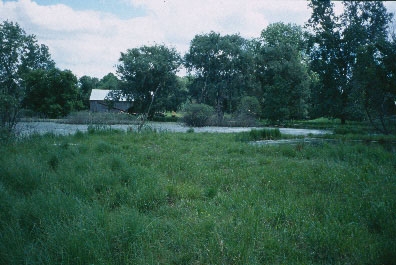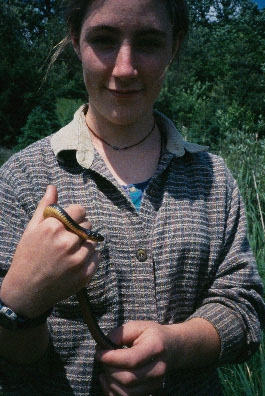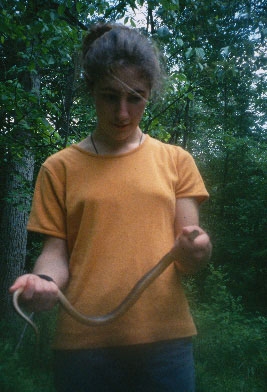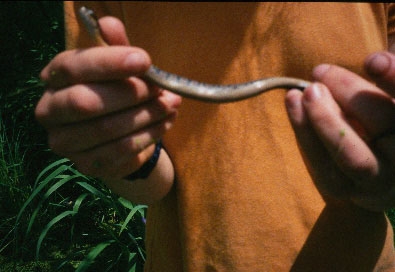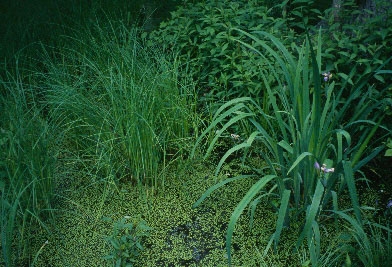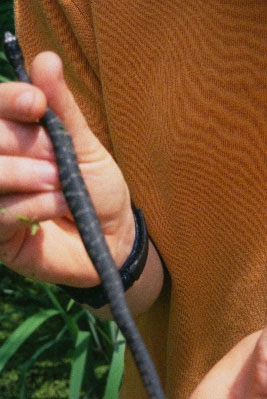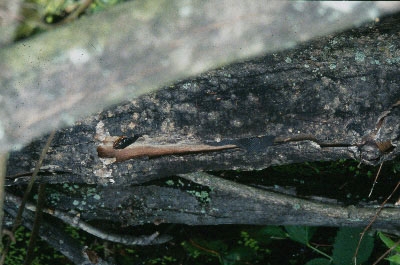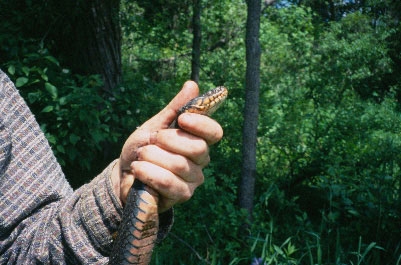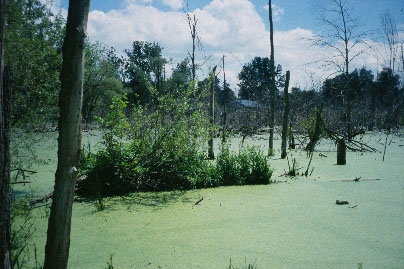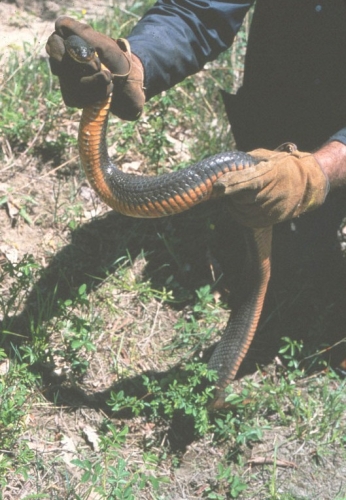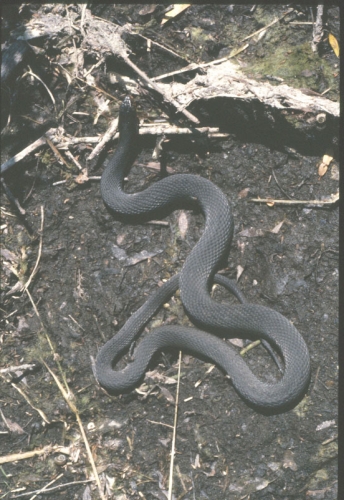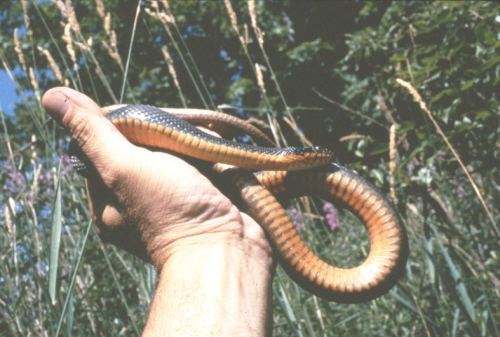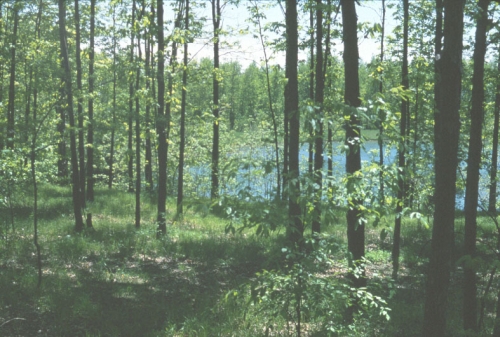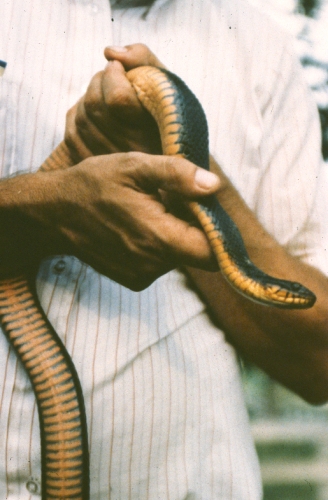Plants and Animals
Nerodia erythrogaster neglecta Copper-bellied water snake
Key Characteristics
The Copperbelly Water Snake is a medium to large, non-venomous, stout-bodied snake, with adults averaging 30 to 40 inches (76-102 cm) in total body length and reaching a maximum length of 56 inches (142 cm). Adults are solid black or dark brown on top with a plain, unmarked, pale orange to bright orange, red or yellow underside or belly. The labial scales or "lips" are orangish or reddish, and the throat and chin are whitish or yellowish to pale or bright orange. Newborn and juvenile snakes are dark brown, reddish or grayish brown to black with saddle-like reddish-brown blotches alternating along the back and fusing into bands near the head. The belly, chin, and labial scales have a pale orange, yellow or pinkish red coloration.
Status and Rank
US Status: LT - Listed Threatened
State Status: E - Endangered (legally protected)
Global Rank: G5T3
State Rank: S1 - Critically imperiled
Occurrences
| County | Number of Occurrences | Year Last Observed |
|---|---|---|
| Branch | 1 | 1987 |
| Calhoun | 2 | 1992 |
| Cass | 1 | 1997 |
| Eaton | 2 | 1959 |
| Hillsdale | 9 | 2017 |
| Oakland | 1 | 1963 |
| St. Joseph | 1 | 1997 |
Information is summarized from MNFI's database of rare species and community occurrences. Data may not reflect true distribution since much of the state has not been thoroughly surveyed.
Habitat
Copperbelly Water Snakes generally prefer forested floodplains and shrubby wetlands that are adjacent to small, shallow lakes and ponds, including ephemeral ponds, and slow-moving rivers. Many of the sites at which Copperbellies have been found are dominated by buttonbush and willow and contain open water areas as well as woody debris near the water for basking. When seasonal ponds begin to recede in the summer, copperbellies will utilize forested corridors to migrate to more permanent bodies of water and forested upland habitats. Winter hibernation sites may be located in crayfish burrows, felled tree-root networks, dense brush piles, fieldstone piles, and muskrat and beaver lodges generally in forested habitat in proximity to their summer habitat. The Copperbelly Water Snake requires large wetland-upland complexes to accommodate its extensive range and movement patterns.
Specific Habitat Needs
Downed woody debris needed in: Dry-mesic southern forest; Emergent marsh; Floodplain forest; Inland lake, littoral, midwater; Inundated shrub swamp; Mesic southern forest; Southern hardwood swamp; Southern wet meadow.
Natural Community Types
- Dry-mesic southern forest
- Emergent marsh
- Floodplain forest
- Inland lake, littoral, midwater
- Inundated shrub swamp
- Mesic southern forest
- Southern hardwood swamp
- Southern wet meadow
For each species, lists of natural communities were derived from review of the nearly 6,500 element occurrences in the MNFI database, in addition to herbarium label data for some taxa. In most cases, at least one specimen record exists for each listed natural community. For certain taxa, especially poorly collected or extirpated species of prairie and savanna habitats, natural community lists were derived from inferences from collection sites and habitat preferences in immediately adjacent states (particularly Indiana and Illinois). Natural communities are not listed for those species documented only from altered or ruderal habitats in Michigan, especially for taxa that occur in a variety of habitats outside of the state.
Natural communities are not listed in order of frequency of occurrence, but are rather derived from the full set of natural communities, organized by Ecological Group. In many cases, the general habitat descriptions should provide greater clarity and direction to the surveyor. In future versions of the Rare Species Explorer, we hope to incorporate natural community fidelity ranks for each taxon.
Management Recommendations
All known extant copperbelly populations should be protected. Habitat conservation and restoration efforts are critical and should strive to 1) protect wetland complexes comprised of a heterogeneous mixture of wetland types, including open and forested wetlands and small, isolated, seasonally inundated depressions, 2) protect or create riparian corridors and habitat corridors between wetlands, 3) protect existing and expand upland forest habitats, and 4) reduce forest fragmentation. Protecting the hydrology of copperbelly sites is also critically important. Permanently lowering water tables can cause seasonally inundated wetlands and hibernacula sites to become permanently dry which could lead to local population extirpations. Maintaining adequate prey base (i.e., mainly frogs) and shrub and log cover along the edge of wetlands for cover and thermoregulation also is crucial.
Active Period
Active from first week of April to first week of November
Breeding from third week of April to fourth week of May
Parturition from first week of September to third week of October
Survey Methods
The best time to see Copperbelly Water Snakes is mid-April through the end of May, when water temperatures are not too great and vegetation has not leafed out. Surveyors should first survey habitats with standing water from a distance with binoculars and then walk on the shore or in the water along the shore looking for snakes that are basking, foraging or traveling. Copperbellies appear to prefer shoreline or edge habitats between open canopy areas and forest or open water and shrubs to bask and rest, and extremely shallow waters (< 4 in/10 cm deep) to forage. They do not spend much time in open, deep water (> 12 in/30 cm), or moving water. However, they are often seen basking on woody debris or in vegetation over deeper water, and will not hesitate to swim across open water. Copperbelly observations should be documented with photographs and verified by a species expert.
Visual encounter surveys
Survey Period: From fourth week of April to fourth week of May
Time of Day: Daytime
Air Temperature: Above 60 degrees
Wind: Light Breeze
References
Survey References
- Karns, D.R. 1986. Field Herpetology: Methods for the Study of Amphibians and Reptiles in Minnesota. Occ. Pap. No. 18. J.F. Bell Museum of Natural History, University of Minnesota, Minneapolis.
Technical References
- Ernst, C. H. and R. W. Barbour. 1989. Snakes of eastern North America. George Mason Univ. Press, Fairfax, VA. 282 pp.
- Evers, D.C. 1994. Endangered and Threatened Wildlife of Michigan. The University of Michigan Press, Ann Arbor. 412pp.
- Harding, J.H. 1997.Amphibians and Reptiles of the Great Lakes Region. The University of Michigan Press, Ann Arbor. 378pp.
- Herbert, N.R. 2003. Comparative habitat use of two water snakes, Nerodia erythrogaster neglecta and Nerodia sipedon sipedon, and implications for conservation. Master's thesis, Purdue University, Ft. Wayne, IN. 79 pp.
- Kingsbury, B. A., and C. J. Coppola. 2000. Hibernacula of the copperbelly water snake (Nerodia erythrogaster neglecta) in southern Indiana and Kentucky. J. Herpetol. 34:294–298.
- Kingsbury, B.A., J.H. Roe and J. Gibson. 2003. Ecology and status of northern populations of the copperbelly water snake. Final report for the Indiana and Ohio Departments of Nat. Res. and the U.S. Fish and Wildlife Service. Ft. Wayne, IN. 186 pp.
- Roe, J. H., B. A. Kingsbury, and N. R. Herbert. 2003. Wetland and upland use patterns in semi-aquatic snakes: implications for wetland conservation. Wetlands 23:1003–1014.
- Roe, J. H., B. A. Kingsbury, and N. R. Herbert. 2004. Comparative water snake ecology: conservation of mobile animals that use temporally dynamic resources. Biol. Conserv. 118: 79–89.
- Sellers, M.A., Jr. 1991. Final report of rangewide survey of the northern copperbelly water snakes. Report to the U.S. Fish and Wildlife Service, Ft. Snelling, MN. 38 pp. + apps.


